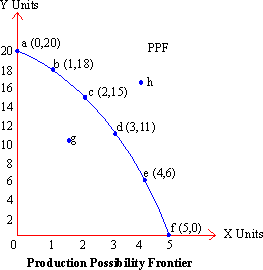|
(C) Production Possibility Frontier and Efficiency: Efficiency is an important condition to be fulfilled during the production of goods and services. Economics provides an efficiency test in all the possible economic activities. Only when the economic agents are acting efficiently (maximizing or minimizing accordingly) can their behavior be called rational and only then can they be subjected to a scientific inquiry.
In the process of production, a simple analytical tool is employed in the form of a production possibility frontier (P.P.F) and a related schedule. This can be illustrated as:
|
Production Schedules |
|
Units of X |
Units of Y |
MRS |
|
0 |
20 |
- |
|
1 |
18 |
(1 - 2) |
|
2 |
15 |
(1 - 3) |
|
3 |
11 |
(1 - 4) |
|
4 |
6 |
(1 - 5) |
|
5 |
0 |
(1 - 6) |
i. Schedule: The table above showing the varying units of X and Y goods produced is called a Production Possibility Schedule. It is a schedule in the sense that at any moment, if we consider the units of X (say 3) to be produced, then the maximum possible units of Y which can be produced (11) can also be known. It is not necessarily based on an empirical or any trial and error method. The relevant information is a result of certain economic hypothesis about production behavior. The schedule is based on certain important assumptions. These include the following :
-
The total quantity of various resources and services available for production is fixed.
All available resources must be fully utilized. Technical conditions and knowledge (methods of production) remain fixed; and, Only two goods X and Y are produced with these resources.
This shows that, at one extreme, a maximum of 20 units of Y can be produced but only by completely sacrificing the production of X (which is zero at that stage). On the other hand, if all the resources are employed to produce 5 units of X then the production of Y will have to be completely forgone. However, the combinations in between these two extremes show that any desirable combination of the two goods (1-18, 2-15....) can be produced conveniently.
There are some interesting features or properties of the P.P. Schedule. First, with every increase in the units of X produced, the units of Y must decrease. This is because the assumption in this analysis is that all the resources of the economy are being utilized to produce only these two commodities (X and Y).
Second, with every additional (marginal) unit of X produced, the number of units of Y to be forgone continues to increase. Whereas the first unit of X requires only 2 units of Y to be sacrificed (that is 20 18), the second unit of X needs 3, and the third needs 4 units of Y to be sacrificed. With an increase in the production of a particular commodity, there is simultaneously a decrease in the production of the second commodity. This is technically known as the marginal rate of substitution (MRS). This is shown in the third column of the schedule. Since the MRS increases progressively, the production of X becomes more and more difficult. This is based on the famous law given by Ricardo: the Diminishing Marginal Returns principle. The schedule can be inverted by reading it upwards, in which case, one can assume that more and more units of Y can be produced at an increasing rate of sacrificing the production of X units.

Figure 1
|